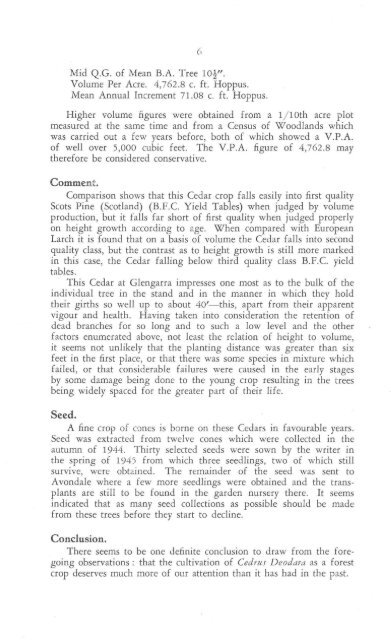Download Full PDF - 17.54 MB - The Society of Irish Foresters
Download Full PDF - 17.54 MB - The Society of Irish Foresters
Download Full PDF - 17.54 MB - The Society of Irish Foresters
You also want an ePaper? Increase the reach of your titles
YUMPU automatically turns print PDFs into web optimized ePapers that Google loves.
Mid Q.G. <strong>of</strong> Mean B.A. Tree lOt".<br />
Volume Per Acre. 4,762.8 c. ft. Boppus.<br />
Mean Annual Increment 71.08 c. ft. Hoppus.<br />
Higher volume figures were obtained from a 1/10th acre plot<br />
measured at the same time and from a Census <strong>of</strong> Woodlands which<br />
was carried out a few years before, both <strong>of</strong> which showed a V.P.A.<br />
<strong>of</strong> well over 5,000 cubic feet. <strong>The</strong> V.P.A. figure <strong>of</strong> 4,762.8 may<br />
therefore be considered conservative.<br />
Comment.<br />
Comparison shows that this Cedar crop falls easily into first quality<br />
Scots Pine (Scotland) (B.F.C. Yield Tables) when judged by volume<br />
production, but it falls far short <strong>of</strong> first quality when judged properly<br />
on height growth according to age. When compared with European<br />
Larch it is found that on a basis <strong>of</strong> volume the Cedar falls into second<br />
quality class, but the contrast as to height growth is still more marked<br />
in this case, the Cedar falling below third quality class B.F.C. yield<br />
tables.<br />
This Cedar at Glengarra impresses one most as to the bulk <strong>of</strong> the<br />
individual tree in the stand and in the manner in which they hold<br />
their girths so well up to about 40'-this, apart from their apparent<br />
vigour and health. Having taken into consideration the retention <strong>of</strong><br />
dead branches for so long and to such a low level and the other<br />
factors enumerated above, not least the relation <strong>of</strong> height to volume,<br />
it seems not unlikely that the planting distance was greater than six<br />
feet in the first place, or that there was some species in mixture which<br />
failed, or that considerable failures were caused in the early stages<br />
by some damage being done to the young crop resulting in the trees<br />
being widely spaced for the greater part <strong>of</strong> their life.<br />
Seed.<br />
A fine crop <strong>of</strong> cones is borne on these Cedars in favourable years.<br />
Seed was extracted from twelve cones which were collected in the<br />
autumn <strong>of</strong> 1944. Thirty selected seeds were sown by the writer in<br />
the spring <strong>of</strong> 1945 from which three seedlings, two <strong>of</strong> which still<br />
survive, were obtc-ined. <strong>The</strong> remainder <strong>of</strong> the seed was sent to<br />
A vondale where a few more seedlings were obtained and the transplants<br />
are still to be found in the garden nursery there. It seems<br />
indicated that as many seed collections as possible should be made<br />
from these trees before they start to decline.<br />
Conclusion.<br />
<strong>The</strong>re seems to be one definite conclusion to draw from the foregoing<br />
observations: that the cultivation <strong>of</strong> Cedrus Deodara as a forest<br />
crop deserves much more <strong>of</strong> our attention than it has had in the past.

















